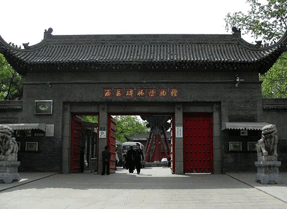|
 Housed in Xi’an’s Confucius Temple, this museum holds over 1000 stone steale (inscribed tablets), including the nine Confucian classics and some exemplary calligraphy. The second gallery holds a Nestorian table (781 A.D.), the earliest recorded account of Christianity in China (the Nestorians professed that Christ was both human and divine, for which they were booted out of the Church in 431 A.D.). The fourth gallery holds a collection of ancient maps and portraits, and is where rubbings are made, an interesting process to watch. All of these record some achievements in the development of the Chinese culture and reflect the historical facts of the cultural exchanges between China and other countries. Housed in Xi’an’s Confucius Temple, this museum holds over 1000 stone steale (inscribed tablets), including the nine Confucian classics and some exemplary calligraphy. The second gallery holds a Nestorian table (781 A.D.), the earliest recorded account of Christianity in China (the Nestorians professed that Christ was both human and divine, for which they were booted out of the Church in 431 A.D.). The fourth gallery holds a collection of ancient maps and portraits, and is where rubbings are made, an interesting process to watch. All of these record some achievements in the development of the Chinese culture and reflect the historical facts of the cultural exchanges between China and other countries.
It was initially established in AD 1087 when some precious stone steles were moved here for safe keeping, including the 'Classic on Filial Piety' written by Emperor Xuanzong in AD 745 and 'the Kaicheng Stone Steles' carved in AD 837. With an area of 31,000 square meters, the Forest of Stone Steles used to be the principal museum for Shaanxi Province since 1944. Then because of the large number of stone steles, it was officially named as the Forest of Stone Steles Museum in 1992.
The highlight is the fantastic sculpture gallery which contains animal guardians from the Tang dynasty, pictorial tomb stones and Buddhist statuary.
 Signup for
Xi'an Tour
and see the famous Terra Cotta Warriors.
Signup for
Xi'an Tour
and see the famous Terra Cotta Warriors.
|

